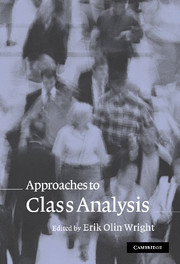Book contents
- Frontmatter
- Contents
- List of figures
- List of tables
- List of contributors
- Introduction
- 1 Foundations of a neo-Marxist class analysis
- 2 Foundations of a neo-Weberian class analysis
- 3 Foundations of a neo-Durkheimian class analysis
- 4 Foundations of Pierre Bourdieu's class analysis
- 5 Foundations of a rent-based class analysis
- 6 Foundations of a post-class analysis
- Conclusion: If “class” is the answer, what is the question?
- References
- Index
5 - Foundations of a rent-based class analysis
Published online by Cambridge University Press: 22 September 2009
- Frontmatter
- Contents
- List of figures
- List of tables
- List of contributors
- Introduction
- 1 Foundations of a neo-Marxist class analysis
- 2 Foundations of a neo-Weberian class analysis
- 3 Foundations of a neo-Durkheimian class analysis
- 4 Foundations of Pierre Bourdieu's class analysis
- 5 Foundations of a rent-based class analysis
- 6 Foundations of a post-class analysis
- Conclusion: If “class” is the answer, what is the question?
- References
- Index
Summary
Introduction
There is an enormous literature on the concept of class that consists mostly of debates about which properties should be included in the concept. The result is a variety of class schemes and arguments that center around which class scheme is most appropriate for capturing the class structure of modern society. Dahrendorf (1959) argues that classes should be identified with authority relations. Ossowski (1963 [1958]), and later Wright (1979), produce class schemes by cross-classifying property and authority or dominance relations. The class scheme identified with John Goldthorpe is based on property, employment, and authority relations (Goldthorpe 1987; Erikson and Goldthorpe 1992). Parkin (1979) and Murphy (1988) emphasize relationships of closure, and Giddens (1973), the degree of “structuration.”
The purpose of the original proposal for the concept of class, by Marx, is to explain inequality, social movements, social conflict, and political processes – to construct a theory of history. The mechanism that produces this extraordinary explanatory power is exploitation of the working class by the capitalist class, which produces antagonistic interests. Interests may be said to be antagonistic when the gain of one actor, or a set of actors, excludes others from gaining the same advantage. The incumbents of classes realize, through a process usually referred to as class formation, that they have these interests and form collective actors that engage in conflicts that eventually change the class structure and society.
- Type
- Chapter
- Information
- Approaches to Class Analysis , pp. 119 - 151Publisher: Cambridge University PressPrint publication year: 2005
- 7
- Cited by



